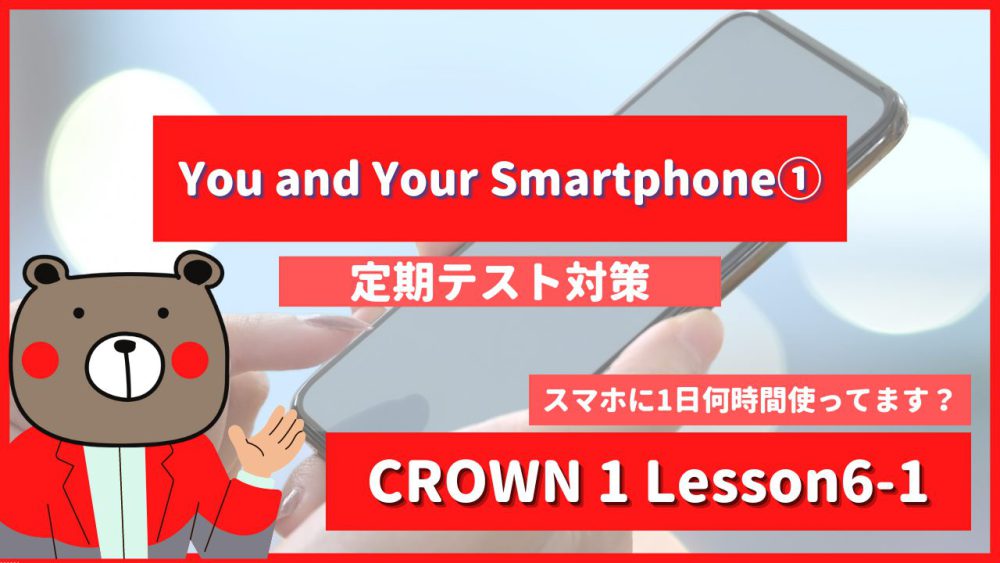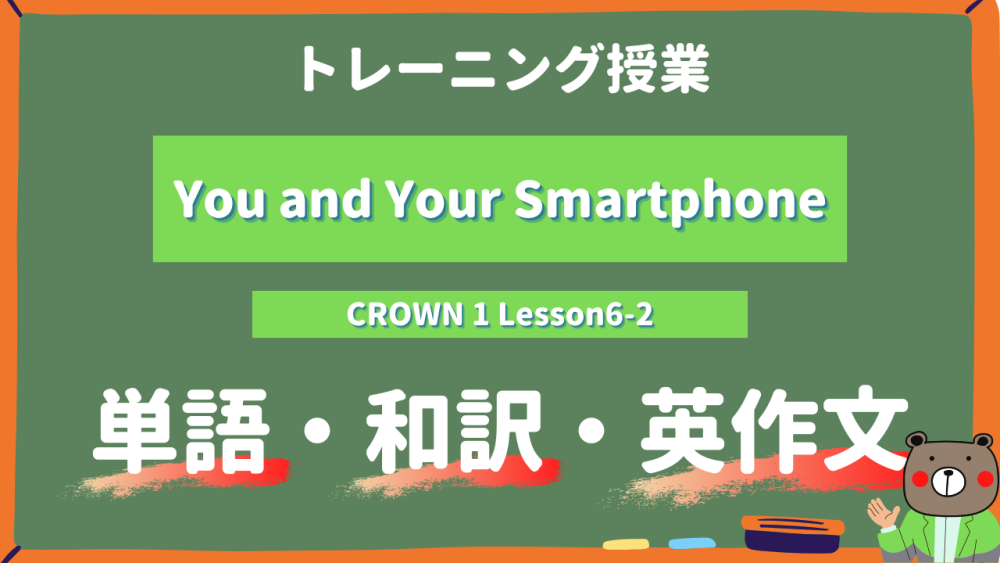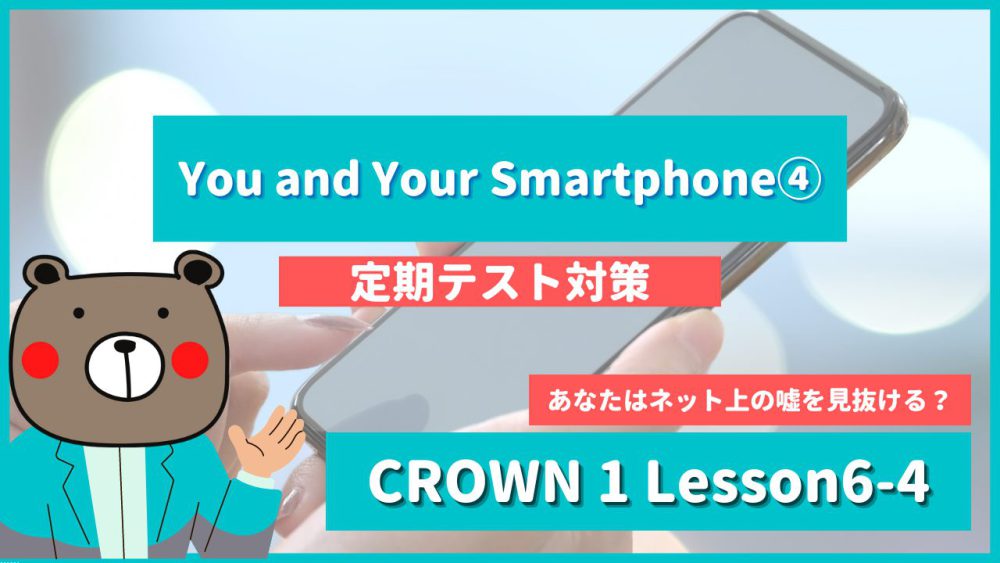▼音声で学びたい方はこちらへ🐻

▼CROWN1-高1《Lesson6》はこちらから🐻
- 授業前にひとこと
- 勉強のポイント
- 本文&和訳
- 重要単語
- 重要ポイント
- 【1】Smartphones are changing our livesーbut not always for the better.
- 【2】There are dangers of misuse.
- 【3】It’s about time to examine carefully whether we are using smartphones in a healthy way.
- 【4】Everywhere we look, we see people bending over their smartphones.
- 【5】They are in their own private world.
- 【6】This kind of scene has become so common that we no longer find it strange.
- 【7】It is estimated that more than four billion people in the world are using smartphones.
- 【8】In Japan, the number of people who own smartphones has been increasing rapidly.
- 【9】In 2011, only 14.6% of the total population was using smartphones.
- 【10】By 2018, the rate had increased to 64.7%.
- 【11】On average, Japanese teenagers spend 143 minutes a day using smartphones just for the Internet, while people in their 20s spend 129 minutes for the same purpose.
- 【12】These figures indicate that we are now living in a new culture where the digital world meets the real world.
授業前にひとこと


今回から、CROWN1-高1《Lesson6》について扱っていきます❗️
Lesson6のタイトルは…🐻
You and Your Smartphone – Who’s in Charge?
という「たくさんの人が所有しているスマートフォン」についてのお話です。
ちなみに、このLessonでメインで理解したい文法事項は…
関係副詞、SVOC(C = 原型不定詞 / 分詞)
です❗️
さて、いつも授業前に説明することですが…
⇧に載せてあります『単語・和訳・英作文トレーニング』をテスト1週間前から毎日やってみてください❗️曖昧な理解がなくなり、成績が爆伸びします!!
コミュ英以外の定期テスト対策は?
現代文の定期テスト対策は こちら から
古文の定期テスト対策は こちら から
漢文の定期テスト対策は こちら から
teite channel をもっと活用する


▷ 解説記事のリクエスト
▷ 新着情報のキャッチ
▷ 定期テスト予想問題
▷ オリジナルグッズの購入
ができるようになっています🐻
teite channel の 公式LINEアカウント はこちら
勉強のポイント
①本文は、スマートフォンに関するデータの紹介であることを理解する。
②単語・重要ポイントをインプットする。
③関係副詞、SVOC(C = 原型不定詞 / 分詞)について理解する。
本文&和訳
序章
Smartphones are changing our livesーbut not always for the better.
スマートフォンは私たちの生活を変えています、しかしいつもより良い方向へ(変えている)とは限りません
There are dangers of misuse.
悪用の危険があります。
It’s about time to examine carefully whether we are using smartphones in a healthy way.
そろそろ、私たちが健全な方法でスマートフォンを使っているかどうかを、注意深く調査する時間です
本文
Everywhere we look, we see people bending over their smartphones.
どこを見ても、私たちは自分のスマートフォンに向けて屈んでいる人々を見ます。
They are in their own private world.
彼らは、彼ら自身の個人的な世界にいます。
This kind of scene has become so common that we no longer find it strange.
こういう種類の場面はとても一般的になってきたので、私たちはもはやそれを奇妙だと思いません。
It is estimated that more than four billion people in the world are using smartphones.
世界中の40億人以上の人々がスマートフォンを使っていると推測されています。
In Japan, the number of people who own smartphones has been increasing rapidly.
日本では、スマートフォンを所有する人の数が急速に増えてきています。
In 2011, only 14.6% of the total population was using smartphones.
2011年、全人口の14.6%だけがスマートフォンを使っていました。
By 2018, the rate had increased to 64.7%.
2018年までに、その割合は64.7%まで増加しました。
On average, Japanese teenagers spend 143 minutes a day using smartphones just for the Internet, while people in their 20s spend 129 minutes for the same purpose.
平均的に、日本の10代は、インターネットのためだけにスマートフォンを使用することに1日143分使っていて、一方20代では同じ目的のために129分費やしています。
These figures indicate that we are now living in a new culture where the digital world meets the real world.
これらの数字は、デジタルの世界が本物の世界と交わるという新しい文化の中で、私たちは今暮らしているということを指し示しています。
重要単語


V : 動詞 , Ving : 動名詞 , Vpp : 過去分詞, O:目的語, C:補語
| charge | 責任、非難 |
| misuse | 悪用 |
| examine | 調査する |
| whether | 〜かどうか |
| bend | 折り曲げる、屈む |
| private | 個人的な、私的な |
| estimate | 推測する |
| rapidly | 急速に |
| population | 人口 |
| rate | 割合 |
| average | 平均 |
| teenager | 10代 |
| indicate | 指し示す |
| digital | デジタルの |
重要ポイント


「ピンク」=重要ポイント
▼記号について
V : 動詞 Ving : 動名詞 Vpp : 過去分詞
【 】名詞句・節 〈 〉形容詞句・節 ( )副詞句・節
S:主語 O:目的語 C:補語 M:副詞
【1】Smartphones are changing our livesーbut not always for the better.
《和訳》
スマートフォンは私たちの生活を変えています、しかしいつもより良い方向へ(変えている)とは限りません
《重要ポイント》
「Smartphones are changing our lives」= スマートフォンは私たちの生活を変えています
・現在進行形で書かれてますね❗️
・つまり「変えている途中だ、最中だ」と言いたいわけです。
「ーbut not always for the better」= しかしいつもより良い方向へ(変えている)とは限りません
・「ー(ダッシュ)」は前の内容の補足説明をする役割❗️
・等位接続詞「but」により、前の部分と同じ箇所は省略されている!
・つまり省略せずに書くと…
・「ーbut Smartphones are not always changing for the better.」となります。
・「not always」= いつも~とは限らない
・「for the better」= より良い方向へ
【2】There are dangers of misuse.
《和訳》
悪用の危険があります。
《重要ポイント》
「danger」= 危険
「misuse」= 悪用、乱用、誤用
【3】It’s about time to examine carefully whether we are using smartphones in a healthy way.
《和訳》
そろそろ、私たちが健全な方法でスマートフォンを使っているかどうかを、注意深く調査する時間です
《重要ポイント》
「It’s about time to examine carefully ~」= そろそろ、~を注意深く調査する時間です
・「It’s about time to V」= そろそろVする時間です
・「examine」= ~を調査する
・「carefully」= 注意深く
「whether we are using smartphones」= 私たちはスマートフォンを使っているかどうか
・「whether ~」= ~かどうか
「in a healthy way」= 健全な方法で
・「healthy」= 健康な、健全な
・「in a ~ way」= ~な方法で
【4】Everywhere we look, we see people bending over their smartphones.
《和訳》
どこを見ても、私たちは自分のスマートフォンに向けて屈んでいる人々を見ます。
《重要ポイント》
「Everywhere we look」= 私たちはどこを見ても
・「everywhere」= どこでも、至るところに
・今回のように「接続詞的に」使う場合は、「どこを〜しても」という意味!
(例)Everywhere I go, ~ 「私がどこへ行っても、〜」
「we see people bending over their smartphones」= 私たちは人々が自分たちのスマートフォンに向けて屈んでいるのを見ます
・「see O Ving」= OがVしているのを見る
・「bend over」= 屈む、傾く
つまり下の写真のような状態の人を見かけるってこと❗️確かにね!


【5】They are in their own private world.
《和訳》
彼らは、彼ら自身の個人的な世界にいます。
《重要ポイント》
「in their own private world」= 彼ら自身の個人的な世界の中で
・「own」= ~自身の
・「private」= 個人的な、私的な
【6】This kind of scene has become so common that we no longer find it strange.
《和訳》
こういう種類の場面はとても一般的になってきたので、私たちはもはやそれを奇妙だと思いません。
《重要ポイント》
「so A that B」= とてもAなので、B
「This kind of scene has become so common」= こういう種類の場面はとても一般的になってきたので
・「so A that B」の「so A」部分ですね❗️
・「this kind of ~」= こういう種類の〜
・「scene」= 場面、シーン
・「common」= 共通の、よくある、普通の、一般的な
「~ that we no longer find it strange」= ~なので、私たちはもはやそれを奇妙だと思わない
・「so A that B」の「that B」部分ですね❗️
・「no longer ~」= もはや~ない
・「find O C」= OをCだと気づく、見つける、分かる
・「strange」= 奇妙な、変わっている
【7】It is estimated that more than four billion people in the world are using smartphones.
《和訳》
世界中の40億人以上の人々がスマートフォンを使っていると推測されています。
《重要ポイント》
「It is estimated that ~」= ~ということが推測されています
・「It is ~ that S V」=SがVすることは~です
・「estimate」= ~を推測する
「more than four billion people」= 40億人以上の人々
・「more than ~」= ~以上の
「in the world」= 世界中の
「~ are using smartphones」= スマートフォンを使っている
【8】In Japan, the number of people who own smartphones has been increasing rapidly.
《和訳》
日本では、スマートフォンを所有する人の数が急速に増えてきています。
《重要ポイント》
「In Japan, 」=日本では
「the number of people」= 人々の数
・「the number of ~」= ~の数
「~ who own smartphones」= スマートフォンを所有する~
・主格の関係代名詞「who」が使われてます❗️
・前の名詞「people」を後ろから補足説明してます。
・「own ~」= ~を所有する
「~ has been increasing rapidly」= ~は急速に増えてきています
・「increase」= 増える、増加する
・「rapidly」= 急速に、急激に
【9】In 2011, only 14.6% of the total population was using smartphones.
《和訳》
2011年、全人口の14.6%だけがスマートフォンを使っていました。
《重要ポイント》
「In 2011, 」= 2011年には
「only 14.6% of the total population」= 全人口の14.6%だけ
・「total」= 全ての
・「population」= 人口
「~ was using smartphones」= スマートフォンを使っていました
【10】By 2018, the rate had increased to 64.7%.
《和訳》
2018年までに、その割合は64.7%まで増加しました。
《重要ポイント》
「By 2018, 」= 2018年までに
「the rate had increased to 64.7%」= その割合は64.7%まで増加してきた
・「rate」= 割合
・「increase to ~」= ~まで増加する
・これは「had + Vpp(過去分詞)」で表す過去完了❗️
・「過去(2011)〜過去(2018)」へ増加してきたということ!
・⇩以下の時間感覚をイメージしておこう


【11】On average, Japanese teenagers spend 143 minutes a day using smartphones just for the Internet, while people in their 20s spend 129 minutes for the same purpose.
《和訳》
平均的に、日本の10代は、インターネットのためだけにスマートフォンを使用することに1日143分使っていて、一方20代では同じ目的のために129分費やしています。
《重要ポイント》
「On average」= 平均的に、平均すると
「Japanese teenagers spend 143 minutes a day using smartphones」= 日本の10代はスマートフォンを使用することに、1日143分費やしています
・「teenager」= 10代
・「spend O Ving」= OをVすることに使う、VすることにOを費やす
・「143 minutes a day」=1日143分
「just for the Internet」= インターネットのためだけに
「while people in their 20s spend 129 minutes」= 一方、20代の人々は129分費やします
・「while」= 一方で
・「20s」= 20代
「for the same purpose」= 同じ目的のために
【12】These figures indicate that we are now living in a new culture where the digital world meets the real world.
《和訳》
あなたはノートを書きこれらの数字は、デジタルの世界が本物の世界と交わるという新しい文化の中で、私たちは今暮らしているということを指し示しています。
《重要ポイント》
「These figures indicate that ~」= これらの数字は〜ということを指し示しています
・「figure」= 数字
・「indicate ~」= ~を指し示す
・「that ~」= ~ということ
「we are now living in a new culture」= 私たちは今新しい文化の中で生きている
「~ where the digital world meets the real world」= デジタルの世界が本当の世界と交わるという〜
・これは関係副詞「where」が使われている❗️
・前の名詞「a new culture」を後ろから補足説明しています。
・直訳すると「デジタルの世界が本当の世界と出会う」になりますね!
・もちろん直訳でもOKですが…
・文脈的に「本当の世界にデジタルの世界が入ってくること」を指しているので⇧のような訳にしています❗️
・将来的にはどちらが本当の世界か分からなくなるんでしょうね!今はまだデジタルが少ない❗️
(執筆時点:2022. 9/1)


これで全て終了です❗️
「CROWN1-高1《Lesson6-1 | You and Your Smartphone – Who’s in Charge? | p94》」おつかれさまでした🐻
関係副詞、SVOC(C = 原型不定詞 / 分詞)だけでなく、知らない熟語や構文が出てきたり、単語のレベルも徐々に上がってきて、少し苦戦しているんではないでしょうか❗️
復習&音読するのをお忘れなく!!
①授業前にひとこと、でも話しましたが…
⇧に載せてあります『単語・和訳・英作文トレーニング』をテスト1週間前から毎日やってみてください❗️曖昧な理解がなくなり、成績が爆伸びします!!
最後まで見てくださってありがとうございました!
またお会いしましょう!定期テストがんばれ〜🐻
じゃあね〜、バイバイ!!
















